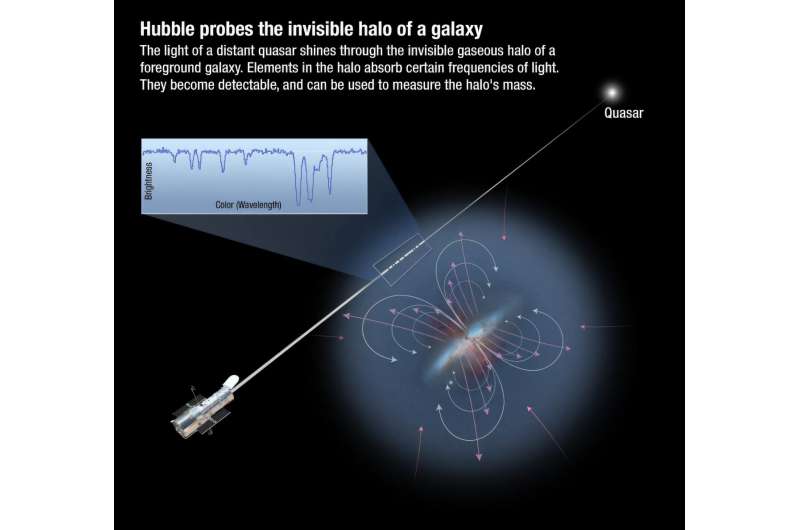Life on Earth could not exist without carbon. But carbon itself could not exist without stars. Nearly all elements except hydrogen and helium—including carbon, oxygen and iron—only exist because they were forged in stellar furnaces and later flung into the cosmos when their stars died. In an ultimate act of galactic recycling, planets like ours are formed by incorporating these star-built atoms into their makeup, be it the iron in Earth’s core, the oxygen in its atmosphere or the carbon in the bodies of Earthlings.
A team of scientists based in the U.S. and Canada recently confirmed that carbon and other star-formed atoms don’t just drift idly through space until they are dragooned for new uses. For galaxies like ours, which are still actively forming new stars, these atoms take a circuitous journey. They circle their galaxy of origin on giant currents that extend into intergalactic space.
These currents—known as the circumgalactic medium—resemble giant conveyer belts that push material out and draw it back into the galactic interior, where gravity and other forces can assemble these raw materials into planets, moons, asteroids, comets and even new stars.
“Think of the circumgalactic medium as a giant train station: It is constantly pushing material out and pulling it back in,” said team member Samantha Garza, a University of Washington doctoral candidate. “The heavy elements that stars make get pushed out of their host galaxy and into the circumgalactic medium through their explosive supernovae deaths, where they can eventually get pulled back in and continue the cycle of star and planet formation.”
Garza is lead author on a paper describing these findings that was published Dec. 27 in The Astrophysical Journal Letters.
“The implications for galaxy evolution, and for the nature of the reservoir of carbon available to galaxies for forming new stars, are exciting,” said co-author Jessica Werk, UW professor and chair of the Department of Astronomy. “The same carbon in our bodies most likely spent a significant amount of time outside of the galaxy.”
In 2011, a team of scientists for the first time confirmed the long-held theory that star-forming galaxies like ours are surrounded by a circumgalactic medium—and that this large, circulating cloud of material includes hot gases enriched in oxygen. Garza, Werk and their colleagues have discovered that the circumgalactic medium of star-forming galaxies also circulates lower-temperature material like carbon.
“We can now confirm that the circumgalactic medium acts like a giant reservoir for both carbon and oxygen,” said Garza. “And, at least in star-forming galaxies, we suggest that this material then falls back onto the galaxy to continue the recycling process.”
Studying the circumgalactic medium could help scientists understand how this recycling process subsides, which will happen eventually for all galaxies—even ours. One theory is that a slowing or breakdown of the circumgalactic medium’s contribution to the recycling process may explain why a galaxy’s stellar populations decline over long periods of time.
“If you can keep the cycle going—pushing material out and pulling it back in—then theoretically you have enough fuel to keep star formation going,” said Garza.

For this study, the researchers used the Cosmic Origins Spectrograph on the Hubble Space Telescope. The spectrograph measured how light from nine distant quasars—ultra-bright sources of light in the cosmos—is affected by the circumgalactic medium of 11 star-forming galaxies.
The Hubble readings indicated that some of the light from the quasars was being absorbed by a specific component in the circumgalactic medium: carbon, and lots of it. In some cases, they detected carbon extending out almost 400,000 light years—or four times the diameter of our own galaxy—into intergalactic space.
Future research is needed to quantify the full extent of the other elements that make up the circumgalactic medium and to further compare how their compositions differ between galaxies that are still making large amounts of stars and galaxies that have largely ceased star formation. Those answers could illuminate not just when galaxies like ours transition into stellar deserts, but why.
More information:
Samantha L. Garza et al, The CIViL* Survey: The Discovery of a C iv Dichotomy in the Circumgalactic Medium of L* Galaxies, The Astrophysical Journal Letters (2024). DOI: 10.3847/2041-8213/ad9c69
Citation:
Carbon in our bodies likely left galaxy and came back on cosmic ‘conveyer belt’ (2025, January 3)
retrieved 5 January 2025
from https://phys.org/news/2025-01-carbon-bodies-left-galaxy-cosmic.html
This document is subject to copyright. Apart from any fair dealing for the purpose of private study or research, no
part may be reproduced without the written permission. The content is provided for information purposes only.

